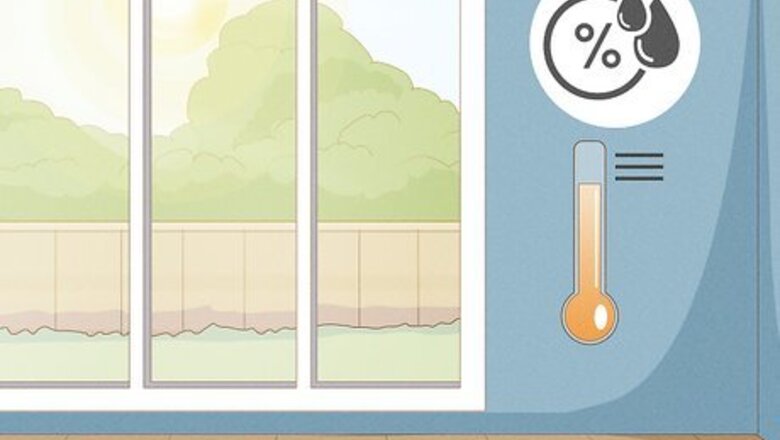
views
Picking Good Growing Conditions

Find a warm growing spot with partial sunlight. As subtropical plants, avocados love sun. Native to Central America, Mexico, and the West Indies, avocados evolved to thrive in warm, humid environments. Though avocados have been bred to grow in locales as far away as California, they always require good sunlight to grow well. However, paradoxically, young avocado plants can be damaged by excessive direct sunlight (especially before they've had time to develop extensive leaves). Because of this, if you are growing an avocado plant from a single pit, you will want to pick a growing spot that has access to good sun during some parts of the day but is not constantly in direct sunlight. Sunny windowsills are great growing sites for avocados. In addition to ensuring that the avocados only receive sunlight during part of the day, indoor windowsills allow you to carefully control the temperature and humidity that the plant is exposed to.
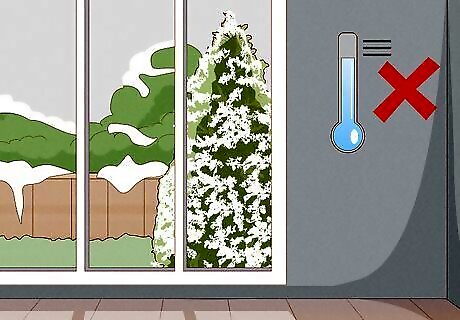
Avoid cold, wind, and frost. For the most part, avocado plants do not do well in inclement weather. Snow, cold winds, and rapid temperature drops, which can be harmful even to hardier plants, can outright kill avocado plants. If you live in a tropic or subtropic climate with fairly mild winters, you may be able to get away with keeping your avocado plant outside year-round. However, if you live in an area where the winter temperature is likely to drop below freezing, you will want to prepare to move your maturing plant indoors for the winter to protect it from the elements. Different avocado varieties have different tolerances for cold temperatures. In general, the common avocado varieties listed below will receive significant freezing damage at the temperatures indicated: West Indian — 28-29 F (-2.2-1.7 C) Guatemalan — 27-29 F (-2.8-1.7 C) Hass — 25-29 F (-3.9-1.7 C) Mexican — 21-27 F (-6.1-2.8 C)
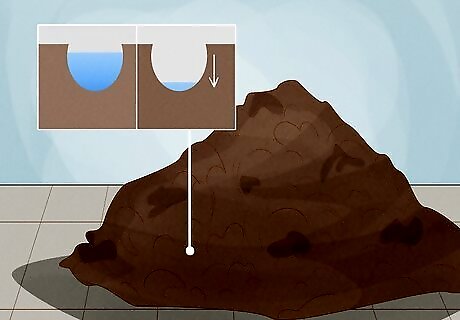
Use rich soil with good drainage. Like a variety of other common garden plants, avocados do best in a loose, rich soil. These types of soils provide great nutrient content to help the plant grow strong while also reducing the danger of over-watering and allowing for great aeration. For the best growing results, try having a supply of this type of soil (like, for instance, one rich in humus and organic matter) ready to use as a potting medium by the time your avocado's roots and stem are well-established. To be clear, you do not necessarily need your potting soil ready at the very beginning of the growing process, as avocado pits are started in water before being transferred to soil.
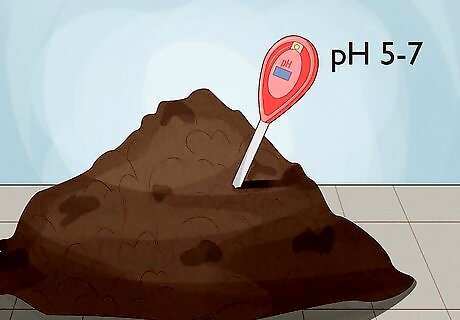
Use a soil with fairly low pH. Like many other common garden plants, avocados grow best in soils that have a low pH (in other words, soils that are acidic, rather than alkaline or basic). For the best results, try to plant your avocado in soil with a pH of 5-7. At higher pH levels, the avocado plant's ability to absorb vital nutrients like iron and zinc can significantly decrease, hindering its growth. If your soil pH is too high, consider using a pH-lowering technique like adding organic matter or introducing alkaline-tolerant plants to your garden. You can also achieve good results with a soil additive like aluminum sulfate or sulfur. For more tricks, see How to Lower Soil pH.
Getting an Avocado Plant Started
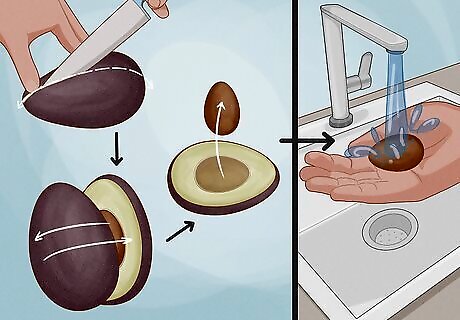
Remove and wash the pit. Getting the pit from a ripe avocado is easy. Use a knife to slice the avocado down the middle lengthwise across both sides, then grab and twist to separate the halves. Dig the pit out of the half of the fruit that it is stuck to. Finally, wash any excess avocado matter that is stuck to the pit until it is perfectly clean and smooth. Do not throw the avocado fruit away — try making guacamole, spreading it on a piece of toast, or eating it raw as a delicious, nutritious snack.
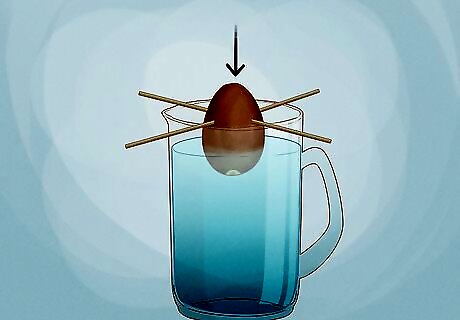
Suspend the pit in water. Avocado pits shouldn't be planted directly into the ground — instead, they need to be started in water until their roots and stem are developed enough to support the plant. An easy way to suspend your pit in water is to stick three toothpicks into the sides of the pit and place the pit so that it sits in the rim of a cup or large bowl. Do not worry — this does not hurt the plant. Fill the cup or bowl with water until the bottom of the pit is just submerged. Make sure that your pit is sitting in the water right side up. The top of the pit should be ever-so-slightly rounded or pointed (like the top of an egg), while the bottom, which is in the water, should be slightly flatter and may have a patchy discoloration compared to the rest of the pit.

Place by a sunny window and replace water as needed. Next, place your pit and its water-filled container in a spot where it will receive occasional (but rarely direct) sunlight, like a windowsill that only receives a few hours of sun per day. Once a week, empty the container and refill with fresh water to keep it clean. Top up with more water mid-week if the level drops below the bottom of the pit. Within a few weeks to about a month and a half, you should notice roots begin to emerge from the bottom of the pit an a small stem begin to emerge from the top. The initial stage of inactivity can take from about two to six weeks. Your pit may not appear to be doing anything, but be patient — eventually, you will see the beginnings of the plant's roots and stem begin to emerge.
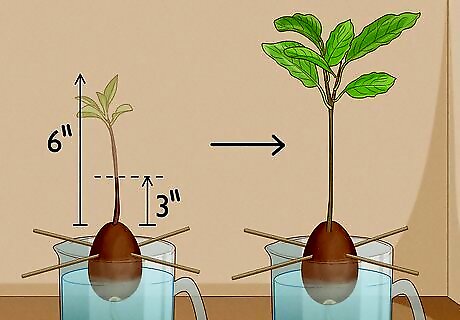
When the stem is about six inches long, cut it back. As the avocado's roots and stem begin to grow, continue monitoring its progress and replacing its water as needed. When the stem reaches a height of about six inches, prune it back to about three inches. Within a few weeks, this should lead to the development of new roots and cause the stem to eventually grow into a wider, fuller tree.
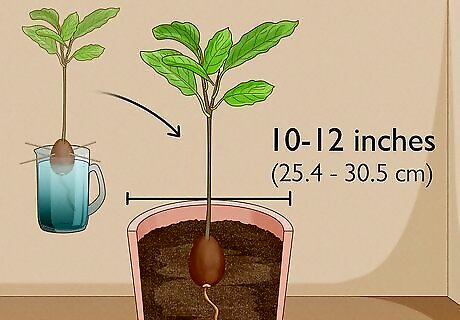
Plant your avocado pit. A few weeks after its first pruning, when the avocado plant's roots are thick and developed and its stem has grown new leaves, you should finally transfer it to a pot. Remove the toothpicks and place the pit roots-down in in an organic matter-rich soil with good drainage. For best results, use a pot about 10-12 inches (25.4-30.5 centimeters) in diameter. Smaller pots can eventually cause the plant to become root-bound, inhibiting its growth if you do not transfer it to a new pot. Do not bury the pit completely in the soil — bury the roots, but leave the top half exposed.
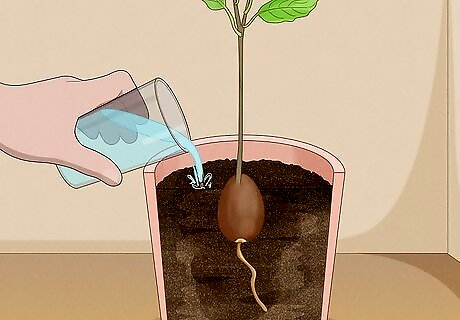
Water the plant frequently. As soon as you pot your avocado plant, give it a good watering, soaking its soil gently but thoroughly. Going forward, you'll want to water just enough to keep the soil slightly damp without ever causing the soil to look saturated or muddy.
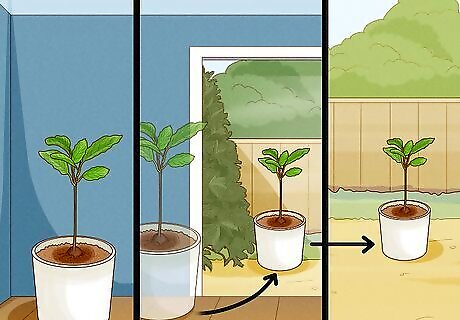
Harden off the avocado plant. Whenever you move a plant outdoors, it helps to expose it to outdoor conditions gradually, or "harden it off". Start the pot in a location that gets indirect sun for most of the day. Gradually move it to brighter and brighter areas. Eventually it will be ready for constant, direct sunlight.
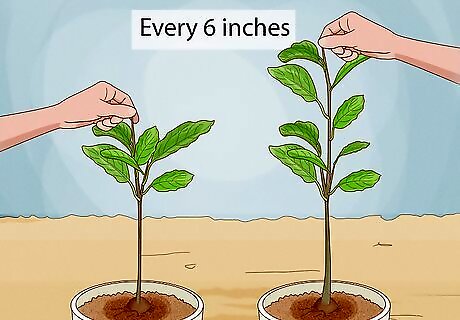
Pinch the leaves off after every six inches of growth. Once your plant has been plotted, continue with your regimen of frequent watering and strong sunlight as it begins to grow. Periodically, monitor its progress with a ruler or tape measure. When the plant's stem reaches a height of about one foot, pinch off any new leaves growing from the tip of the stem, leaving the others intact. As the plant continues to grow, pinch off the newest, highest sets of leaves every time it grows another six inches. This encourages the plant to grow new shoots, leading to a fuller, healthier looking avocado tree in the long run. Do not worry about hurting your plant — avocados are hardy enough to recover from this routine pruning without a problem.
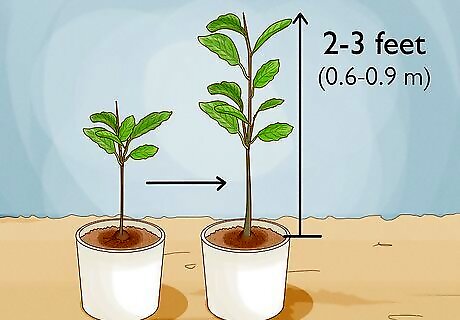
Grow your seedling to about 2-3 feet (0.6-0.9 meters) tall. As noted above, growing an avocado tree from a pit doesn't necessarily mean that you'll be able to grow your own avocados within a practical time frame. Some avocado trees can take a few years to start producing fruit,, while others may struggle to produce fruit for much longer or may even never bear good fruit. To speed this process up and ensure your tree produces great fruit, use the technique that professional growers use — budding. To bud, you'll need access to an avocado tree that is already producing good fruit and an avocado seedling that is at least 24 to 30 inches (60 to 75 centimeters) tall. If you can, try to find a "producer" tree that is hardy and disease-free in addition to producing good fruit. A successful budding physically joins your two plants together, so you'll want to use the healthiest plants possible to avoid issues with their health down the road.
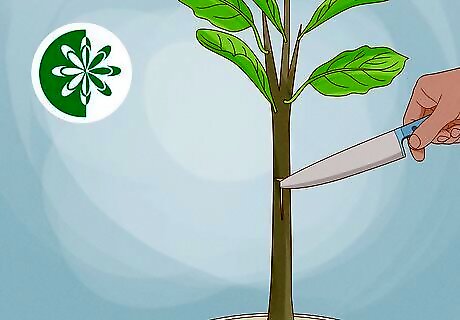
Start in spring. It's easiest to join the two plants together while they are actively growing, and before the weather gets too dry. Get started in spring and expect the process to take about four weeks.
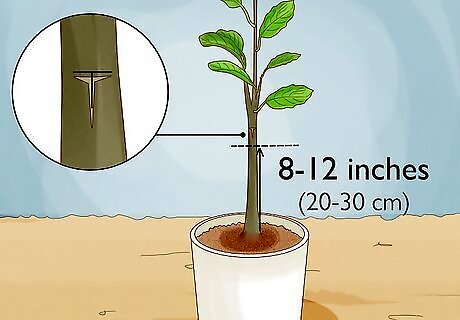
Make a T-shaped cut in the seedling. Using a sharp knife, make a T-shaped cut on the plant's stem about 8 to 12 inches (20 to 30 centimeters) from the ground. Cut horizontally through about one third of the stem's thickness, then turn the knife and cut about an inch down the stem towards the ground. Use the knife to peel the bark away from the stem. Obviously, you'll want to avoid cutting too far into the stem. Your goal is to "open up" the bark along the side of the stem so that you can join a new limb to it, not to damage the seedling.
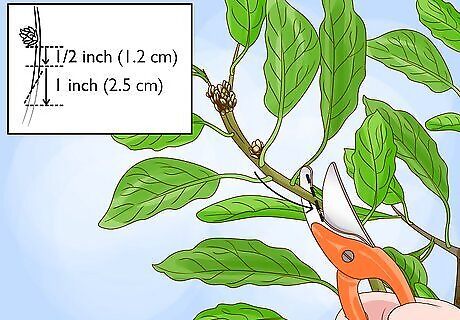
Cut a bud from the "producer" tree. Next, find a healthy-looking bud on the fruit-producing tree you've selected. Remove it from the tree by making a diagonal cut that starts about 1/2 inch (1.2 centimeters) below the bud and ends about 1 inch (2.5 centimeters) below it. If the bud is in the middle of a section of branch or twig, rather than at its tip, make a cut an inch above the bud as well to remove it,
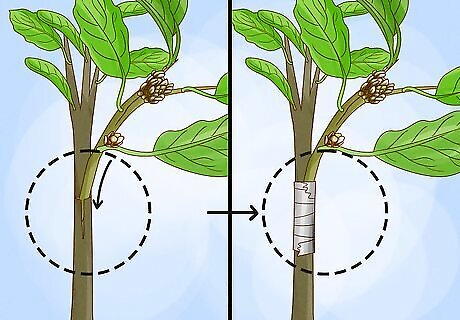
Join the bud to the seedling. Next, slide the bud clipping you removed from the "producer" tree into the T-shaped cut on the seedling. You want the green material under the bark of each plant to touch — if this does not happen, the budding may fail. Once the bud clipping is seated in the slit of the seedling's cut, secure it in its place with rubber bands or budding rubber (a specialty substance available at most gardening stores).
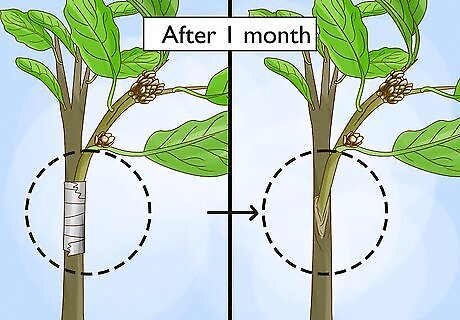
Wait for the bud to take. If your budding effort succeeds, the bud clipping and the seedling should eventually heal together, forming one seamless plant. Following a spring joining, this process usually happens within a month. Once the plant is fully healed, you may remove your rubber bands or budding rubber. If desired, you can also carefully cut the stem of the original plant an inch or two above the new offshoot to make it the new "main" branch. Keep in mind that avocados planted from seed can take 5-13 years or more before they flower and produce fruit.
Caring for an Avocado Plant
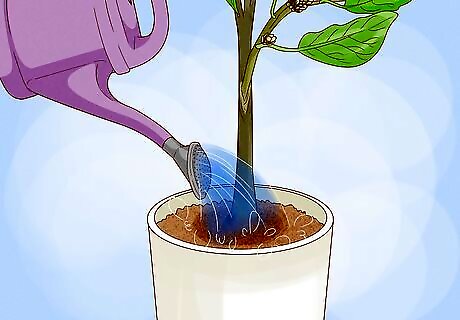
Water frequently, but avoid over-watering. Compared to other plants in your garden, avocado plants may require lots of water. However, it's important to remember that over-watering is a potential problem for nearly all plants, including avocados. Try to avoid watering so frequently or thoroughly that the avocado tree's soil looks liquid or muddy. Use a soil with good drainage (one rich in organic matter is usually a good bet). If your tree is in a pot, be sure that the pot contains drainage holes in the bottom to allow the water to escape. Follow these simple tips, and your plant should be free from the danger of over-watering. If your plant's leaves begin to turn yellow and you have been watering frequently, this may be a sign of over-watering. Immediately stop watering and begin again only once the soil is dry.
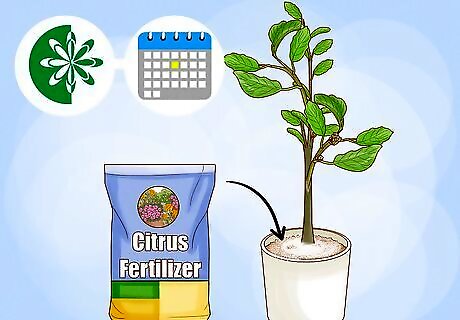
Fertilize only occasionally. You may not need fertilizer at all to grow a strong, healthy avocado tree. However, if they're used sensibly, fertilizers can noticeably boost a young plant's growth. Once the tree is well established, add balanced citrus fertilizer to the soil during the growing season according to the directions included with the fertilizer. Do not overdo it — when it comes to commercial fertilizer, it is usually best to be somewhat conservative. Always water after fertilizing to ensure the fertilizer is absorbed into the soil and delivered directly to the plant's roots. Like many plants, avocados generally should not be fertilized when they are very young, as they can be very susceptible to the "burn" that can result from overusing fertilizer. Try waiting at least a year before fertilizing.
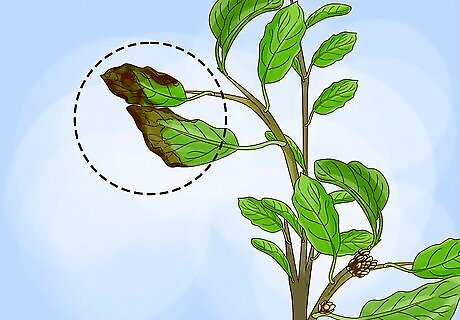
Watch for signs of salt buildup. Compared to other plants, avocados can be especially vulnerable to the buildup of salt in the soil. Avocado plants suffering from high salt levels may have slightly wilted leaves with "burnt", brown tips where excess salt is accumulating. To lower the salinity (saltiness) of your soil, change your watering practices. At least once a month, try to water heavily, soaking the soil. The heavy water flow carries built-up salts deep into the soil, below the roots where they'll be less harmful to the plant. Potted plants are especially susceptible to salt buildup. Once a month, place the pot in a sink or outside, then let water flow completely through the pot and drain out the bottom.
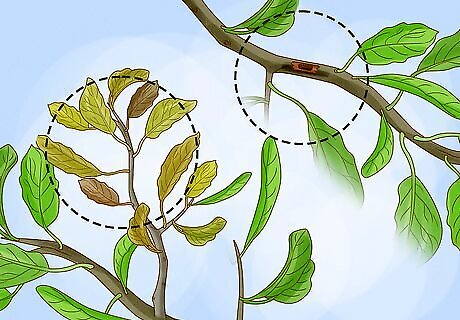
Know how to beat common avocado pests and ailments. Like any agricultural crop, avocado plants can suffer from a variety of pests and diseases that may threaten the quality of the plant's fruit or even endanger the entire plant. Knowing how to recognize and solve these issues is crucial to maintaining a healthy, productive avocado tree. Below are just a few of the most common avocado pests and illnesses — for more information, consult a botanical resource: Cankers — "Rusty", sunken sores on the plant that may ooze gum. Cut cankers from affected branches. Cankers on the trunk of the tree may kill the plant. Root rot — Usually caused by over-watering. Causes yellowing leaves, wilting, and eventual decay even when all other conditions for growth are being met. Immediately stop over-watering and, if severe, dig up the roots to expose them to air. Sometimes fatal to plant. Wilts and Blights — "Dead" patches on the tree. Fruits and leaves within these patches wither and die. Remove the affected areas from the tree immediately and wash the tools you use to do so before using them again. Lace bugs — Cause yellow spots on leaves that quickly dry out. Damaged leaves my die and drop from the branch. Use a commercial pesticide or a natural insect-killing substance like pyrethrin. Borers — Bore into tree, creating small holes that may ooze sap. Preventative cure is best — keeping trees healthy and well-nourished makes it harder for trees to be affected. If borers are present, remove and discard any affected branches to decrease their spread.

















Comments
0 comment